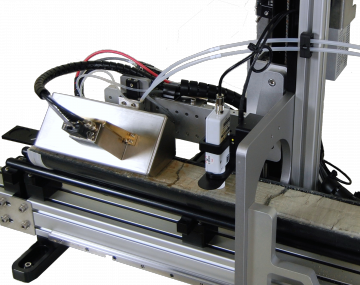MSCL-XRF:
X-ray Fluorescence (XRF) spectroscopy
and Multi-Sensor Core Logging
Geotek offers a range of specialised core scanning/logging equipment that use XRF spectrometers to acquire elemental abundance from the surface of sediment and rock cores. The ability to continuously scan core samples using both petrophysical and spectroscopic techniques is a product unique to Geotek. XRF spectrometers can now be integrated into new or existing MSCL systems.
An MSCL is the perfect platform to acquire XRF data as it offers a stable and repeatable measurement geometry with each measurement depth co-registered with other spectroscopy and petrophysical sensors. Geotek offers two XRF spectrometers: the high resolution and ultra-sensitive Geotek XRF, and the popular hand-held Olympus Vanta. These are compatible with a range of different MSCL systems including: the standard MSCL-S, the small footprint MSCL-XZ, and the multiple core/core box workstation MSCL-XYZ.






